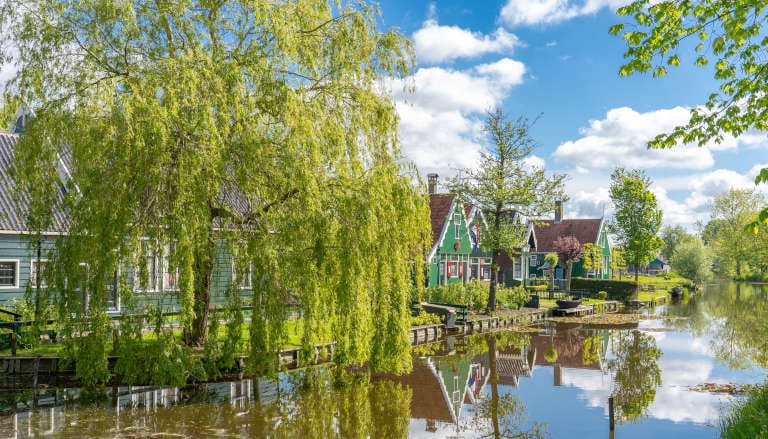
Unveiling Co-Housing: A Green & Communal Blueprint for Contemporary Living
In an era where digital connections abound yet true community feels increasingly elusive, a quiet revolution is unfolding in residential living.
Co-housing offers a compelling alternative—vibrant communities that blend private sanctuaries with shared resources and communal spaces.
Imagine a place where environmental sustainability isn’t just discussed but lived daily, where personal growth happens collectively, and where neighbors become extended family.
This transformative approach weaves green architecture with community-oriented living, addressing our modern yearning for connection and purpose.
As we explore co-housing’s roots and philosophy, you’ll discover its profound benefits—from environmental sustainability to enhanced well-being.
We’ll guide you through inspiring global examples and practical insights for those curious about this path.
Join us in reimagining our relationship with home, environment, and community.
Step into a world where sharing replaces owning, inclusivity trumps exclusivity, and thriving becomes the new living—a conscious response to our increasingly isolated modern existence.
You’re Not Meant to Walk Alone
Join conscious seekers and illuminate your true self. Unlock higher awareness, spiritual growth, and whole-person well-being.
Join the Wholebeing Newsletter Today!
By signing up, you agree to receive our well-being emails, special offers, and agree to the Privacy Policy. You can unsubscribe at any time.
Co-Housing: Unraveling the Concept
Peeling back the layers of co-housing takes us on a journey through time, tracing the origins and evolution of this unique residential model.
Born in Denmark in the late 1960s as “bofællesskab” (literally “living community”), co-housing emerged from forward-thinking families seeking a harmonious fusion of privacy and community—elements often lacking in traditional housing structures.
The concept migrated to North America in the 1980s through architects Charles Durrett and Kathryn McCamant, who became passionate advocates after encountering the Danish model during their European studies.
They adapted these principles to American cultural contexts, helping spark a movement that has since blossomed globally from Europe to Australia and Asia.
This worldwide growth has been fueled by increasing environmental awareness and a collective yearning to escape the isolation of suburban life.
While specific structures vary across cultures and regions, the essence remains consistent: creating spaces that foster intentional communities, emphasize shared resources, and prioritize environmental responsibility.
At its core, co-housing embodies a profound philosophy championing unity and human connection.
It’s rooted in interdependence, where each member contributes to the whole, creating an environment that enriches life on multiple levels.
This delicate blend of private homes with shared communal resources not only promotes sustainability but fosters lasting bonds between residents.
The philosophy extends beyond physical proximity to encompass shared values, collective vision, and joint commitment to mutual support.
Co-housing encourages us to view neighbors as extended family, embarking together on a journey toward holistic well-being.
It cultivates togetherness, addressing our innate need for connection that modern urban sprawl often neglects.
Therein lies co-housing’s true allure—it invites us to reimagine living spaces where community harmonizes with individual freedom, mutual respect, and shared environmental responsibility.
As we navigate the complexities of the 21st century, co-housing emerges not merely as a testament to our communal past but as a promising blueprint for our shared future, offering an alternative path to sustainable, community-focused, and meaningful lives.

Exploring the Benefits of Co-Housing
Environmental Sustainability
Co-housing architecture transcends mere construction—it’s about building a sustainable future where every design decision reflects a deep commitment to environmental preservation.
These communities are meticulously designed to minimize ecological footprints through thoughtfully balanced private and shared spaces.
The architectural approach features compact buildings often oriented for passive solar gain, equipped with advanced insulation, rainwater collection systems, and renewable energy installations.
Strategic locations near public transportation and local amenities reduce vehicle dependence, while shared cars and bicycles further diminish carbon emissions.
This green vision extends seamlessly into daily community practices.
Shared resources significantly reduce consumption of energy, water, and materials across households.
Communal meal preparation minimizes food waste through bulk buying, while shared tools and appliances decrease unnecessary production and individual consumption.
Community gardens flourish in these spaces, encouraging local food production, fostering earth connection, and promoting biodiversity.
Standard practices like composting and recycling close the resource loop, completing a comprehensive approach to sustainability.
The cumulative impact of these integrated design choices and daily practices is profound.
Co-housing communities dramatically reduce their carbon footprints, setting a compelling environmental standard for residential development.
They embody the promise of sustainable living, demonstrating how intentional collective choices create pathways toward a healthier planet.
Fostering Community & Personal Growth
In an era of towering skyscrapers and isolated living, co-housing offers a breath of fresh air—constructing not just houses, but vibrant communities.
At its heart lies the principle of interconnectedness, where thoughtfully designed spaces nurture a profound sense of belonging and shared purpose.
These communities feature intentional architecture that encourages natural interaction—shared kitchens for communal meals, open green spaces for children to play, and common rooms for gatherings and celebrations.
The magic of co-housing happens in ordinary moments—passing on a garden path, cooking together in the communal kitchen, or enjoying impromptu coffee chats.
Through these daily interactions, individuals transform into a community, creating a vibrant tapestry of shared experiences, mutual support, and collective joy.
Beyond shared spaces and meals, co-housing offers abundant opportunities for personal development.
The community functions as a living, breathing university where residents learn collaboration, conflict resolution, and empathy through daily practice.
Living closely with diverse individuals naturally cultivates open-mindedness and cultural sensitivity, while participation in community decision-making develops leadership skills and civic responsibility.
In this environment, every resident becomes both teacher and student.
The regular sharing of skills and knowledge—whether gardening, cooking, music, language, or yoga—enhances personal abilities, sparks new interests, and enriches life immeasurably.
The practical sharing of chores and responsibilities also liberates personal time for individual pursuits, hobbies, and relaxation, fostering a more balanced and fulfilling lifestyle than conventional living arrangements can typically provide.
Enhancing Holistic Well-Being
Shattering the walls of isolation, co-housing illuminates a path to enhanced mental and physical health through intentional community design.
Living surrounded by support and friendship creates a buoyant force against the stress and loneliness that often characterize modern lifestyles.
The wealth of social interactions naturally fosters belonging and reduces isolation, significantly boosting mental health.
Numerous studies corroborate this connection, confirming the invaluable emotional support that stems from these integrated community relationships.
Physical health flourishes equally in these environments through their emphasis on active living and shared meals.
The very design of co-housing communities encourages natural movement—through communal gardening, property maintenance, or simply walking to visit neighbors.
Communal meals typically feature healthier, home-cooked food, offering a nourishing alternative to the processed options that dominate contemporary diets.
The embrace of co-housing represents more than a sustainable living arrangement—it’s a celebration of holistic well-being that seamlessly integrates physical health, mental wellness, and social fulfillment.
Shared decision-making processes empower individuals, boost self-confidence, and nurture purpose, while strong community bonds provide a safety net of emotional support.
Collaborative responsibilities like cooking and gardening simultaneously encourage physical activity and bring a sense of accomplishment and mutual aid, contributing to emotional resilience.
Connection with nature, often central to co-housing design, offers a serene sanctuary from life’s frenetic pace, fostering calm and tranquility.
This focus on sustainable living aligns with growing environmental consciousness, lending residents a profound sense of purpose and fulfillment that extends beyond individual well-being to planetary health—completing a truly holistic approach to thriving rather than merely surviving.

Real-Life Communities from Around the Globe
Embarking on a global journey to explore co-housing, we are graced with a kaleidoscope of thriving, interconnected communities.
These living testimonies of co-housing stretch from the lush meadows of Northern Europe to the sun-kissed landscapes of California, and even further afield.
They are vibrant social tapestries, weaving diverse individuals into a shared narrative of interconnected living.
Take a stroll through the community of Munksoegaard in Denmark, set amidst sparkling streams and lush meadows.
Here, sustainable living is not just a concept but a daily practice.
Residents tending to organic gardens and children’s laughter echo through the car-free zones, painting a picture of a vibrant community life.
In the Sierra Nevada foothills, you’ll discover a similar harmony at the Nevada City Cohousing in California.
Residents share more than just a postal code; they share meals, gardening tasks, and decision-making processes.
Impromptu gatherings and the sharing of skills and knowledge add vibrancy to their shared life.
Yet, our exploration doesn’t stop here.
Venture into the Southern Hemisphere, and you’ll encounter Earthsong in New Zealand, an eco-neighborhood that stands as a beacon of sustainable living.
Despite being nestled amidst native trees and gardens, it’s the sense of community that truly shines here.
Residents, ranging from toddlers to seniors, create a symphony of life, underpinned by sustainable practices and consensus decision-making.
Our journey continues to Sættedammen in Denmark, the world’s first modern co-housing community.
A living testament to cooperative living since the 1960s, it paints a vivid picture of dynamic, vibrant community life.
From children playing freely in car-free courtyards to adults gathering for meals or discussions, there is an undeniable sense of interconnectedness here.
Emerging from the dynamic pulse of Tokyo, “share houses” — Japan’s urban co-living communities — are transforming city living.
These spaces cleverly weave together private and shared areas, kindling community spirit within the city’s brisk rhythm.
In the midst of urban hustle, residents sustain a shared lifestyle, engaging in mutual activities and support.
Their gatherings for meals, networking, and shared upkeep in communal spaces, epitomize co-living’s adaptability within dense city landscapes.
Each of these case studies unveils a different facet of co-housing, underlining its versatility and adaptability across cultures and geographies.
The physical environments may differ, but the shared principles of resource sharing, active participation, and mutual support remain the same.

Your Journey Towards Co-Housing
Finding & Integrating Into a Co-Housing Community
As the call of co-housing beckons, a path of discovery, community, and connection awaits.
More individuals and families than ever are resonating with this sustainable and community-oriented lifestyle.
Whether you’re poised on the cusp of this adventure or simply curious about exploring new horizons, let’s shed some light on the path towards discovering and assimilating into a co-housing community.
Your journey begins with a moment of introspection.
What pulls you towards co-housing?
What hopes and expectations bubble to the surface?
Reflect on these whispers of curiosity.
They will be your guiding light, helping to align your desires and commitments as you venture into the world of co-housing.
With your compass aligned, the exploration begins.
Dive deep into the tapestry of co-housing communities, spanning across the nation and beyond.
Your exploration will be a mix of comprehensive research and direct contact with existing communities, helping you understand the unique ethos, structure, and dynamics of each one.
Books, online resources, and first-hand accounts are your guides.
The exploration will eventually lead you to a shortlist of communities that spark your interest.
Once you find them, immerse yourself.
Attend open days, be part of community meetings, and if possible, experience the community life first-hand.
These experiences will offer an unfiltered glimpse into the rhythm of life within these shared spaces.
Each co-housing community is unique and thrives on its diversity.
Find a community that resonates with your spirit and aligns with your lifestyle and values.
And remember, patience is your ally.
The journey to find the right community may be winding, but the ultimate reward lies in a place that feels like home.
Once you’ve discovered your co-housing home, the transition begins.
This involves more than just moving in—it’s about immersing yourself in the communal rhythm.
From shared activities and decision-making to nurturing the well-being of the community, every thread is part of the co-housing tapestry.
Key Considerations for Curious Explorers
Intrigued by the world of co-housing?
Here are several key considerations to ponder, acting as your compass points guiding you through this uncharted terrain.
First, consider the essence of community living.
This is not merely about shared spaces, but about shared lives and values.
The joys of camaraderie, the growth from mutual learning, and the comfort of shared responsibilities are as integral to co-housing as are the challenges of consensus-building and conflict resolution.
Next, contemplate your personal space needs versus your desire for community interaction.
Co-housing typically entails private living areas within a broader communal setting.
Thirdly, reflect upon your readiness to participate actively in a co-housing community.
Co-housing thrives on participation, whether it’s decision-making, community-building activities, or the maintenance of shared spaces.
Envision your role and your capacity to contribute to the shared dynamics of the community.
Financial implications are another significant consideration.
Investigate the financial structure of potential co-housing communities to ensure it aligns with your financial circumstances and expectations.
The financial models can vary widely, so a clear understanding is essential to avoid any surprises down the road.
Lastly, remember that co-housing is about sustainability – both environmental and social.
It’s not just about living lightly on the Earth, but also about building and nurturing sustainable relationships.
Reflect on how this aligns with your personal values and your vision for a fulfilling life.
As curiosity propels you towards the possibility of co-housing, these considerations will help navigate your exploration.
They’re not just about finding a place to live, but a way to live that resonates with your core values, lifestyle preferences, and aspirations for community and sustainability.

I hope my content sparks something deeper within: a moment of clarity, a gentle shift, or a deeply felt truth. Creating meaningful content takes time and heart. If you found value here, consider supporting my work to keep this space alive.
Vlad
Final Thoughts
As our exploration of co-housing concludes, we’ve discovered far more than an alternative living arrangement.
We’ve uncovered a vibrant tapestry where sustainability, community, and personal growth intertwine to create something truly transformative.
In co-housing, everyday moments become meaningful through sustainable practices and mutual care.
Private spaces and shared areas dance in harmony, celebrating individuality within community.
Beyond shared walls and gardens lies something profound—shared aspirations, collective resilience, and a unified commitment to nurturing both personal and communal well-being.
You now carry with you a seed—the possibility of a more connected, sustainable way of living.
Whether your next step leads directly to a co-housing community or simply to sharing this knowledge with others, remember that each choice matters.
Each brings us closer to a world where we live not merely beside each other, but with each other, in genuine harmony and respect.
Share the Love, Spread the Wisdom
You May Also Like:



